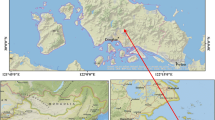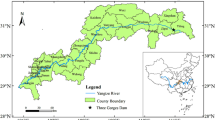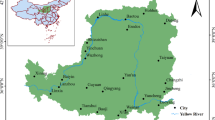Abstract
Most impacts on ecosystem services (ESs) are related to land use changes that may cause ecosystem fragmentation and loss of ecosystem functions. Spatial planning focused on sustainable landscape development should consider the local potential for providing ESs as well as ecological conservation due to land use changes. To better address the issues that are related to ecological and the ecological and environmental conservation, ecological compensation could coordinate the development of the energy, the economy, and the environment by internalizing environmental externalities and adjusting for the relationships with stakeholders’ benefits. In this study, we developed a framework for analyzing the spatial characteristics of land uses and calculating ecological compensation based on pay for ecosystem services (PESs) from 1995 to 2010 in the upstream of Min River, China. In terms of lacunarity analysis, we firstly explored the spatial patterns of land uses in these two periods that occurred at different spatial characteristic scales. We also observed a strong relationship between lacunarity values and the different distribution patterns of land uses. We then investigated changes in ESs in response to land use change through the assignment of per unit area ecological service value (ESV) method. The total value of ESs dropped from 449.97 billion yuan in 1995 to 441.35 billion yuan in 2010, exhibiting decreasing rate, mainly due to the degradation of woodlands. Soil formation and retention, gas regulation, and biodiversity protection were the three largest ESs, contributing about 50% of the total ESV. Considering the changed relation between social and economic indicators and ESV based on spatial visualization and analysis, we finally constructed a quantitative estimate model for ecological compensation taking a village as study unit and determined standard value so as to evaluate ecological compensation from 1995 to 2010. Spatial differences of the ecological compensation were significant among all the villages and towns. The maximum ecological compensation account (ranged from 1.68 to 8.54 billion yuan) appeared in the villages approximated to Li County, Heishui County, and Songpan County, Sichuan, People’s Republic of China. This proposed framework provides a better understanding of spatial characteristic scales of land uses and enables evaluation of the ecological integrity of landscapes. It also fills up the gap in the field of quantitative evaluation of regional ecological compensation and provides a feasible way to reconcile the conflicts among benefits in the economic, social, and ecological sectors.







Similar content being viewed by others
References
Allain C, Cloitre M (1991) Characterizing the lacunarity of random and determined fractal sets. Phys Rev A 44:3552–3558
Allen AO, Feddema JJ (1996) Wetland loss and substitution by the Section 404 permit program in southern California, USA. Environ Manag 20:263–274
Bonan GB (2002) Ecological climatology. Cambridge University Press, Cambridge, UK
Bradshaw GA, Fortin MJ (2000) Landscape heterogeneity effects on scaling and monitoring large areas using remote sensing data. Geogr Inform Sci 6:61–68
Cheng Q (1997) Multifractal modeling and lacunarity analysis. Math Geol 29(7):919–932
Costanza R (2008) Ecosystem services: multiple classification systems are needed. Biol Conserv 141:350–352
Costanza R, d’Arge R, de Groot R et al (1997) The value of the world’s ecosystem services and natural capital. Nature 387:253–260
Daily GC, Polasky S, Goldstein J, Kareiva PM, Mooney HA, Pejchar L, Ricketts TH, Salzman J, Shallenberger R (2009) Ecosystem services in decision making: time to deliver. Front Eclo Environ 7:21–28
Dietz S, Adger WN (2003) Economic growth, biodiversity loss and conservation effort. J Environ Manag 68:23–35
Egoh B, Reyers B, Rouget M, Richardson DM, le Maitre DC, van Jaarsveld AS (2008) Mapping ecosystem services for planning and management. Agric Ecosyst Environ 127:135–140
Fan M, Shibata H, Chen L (2017) Environmental and economic risks assessment under climate changes for three land uses scenarios analysis across Teshio watershed, northernmost of Japan. Sci Total Environ 599-600:451–463
Fan M, Shibata H, Chen L (2018) Assessing high-impacts of climate change: spatial characteristics and relationships of hydrological ecosystem services in Northern Japan (Teshio river watershed). Mitig Adapt Strateg Glob Change 23:525–552
Fan M, Shibata H, Wang Q (2016) Optimal conservation planning of multiple hydrological ecosystem services under land use and climate changes in Teshio river watershed, northernmost of Japan. Ecol Indic 62:1–13
Fan M, Shibata H (2015) Simulation of watershed hydrology and stream water quality under land use and climate change scenarios in Teshio River watershed, northern Japan. Ecol Indic 50:79–89
Fan M, Shibata H (2014) Spatial and temporal analysis of hydrological provision ecosystem services for watershed conservation planning of water resources. Water Resour Manag 28:3619–3636
Frazer G, Wulder M, Niemann O (2005) Simulation and quantification of the fine-scale spatial pattern and heterogeneity of forest canopy structure: a lacunarity-based method design for analysis of continuous canopy heights. Forest Ecol Manag 214:65–90
Gelman A, Hill J (2006) Data analysis using regression and multilevel/hierarchical model. Cambridge University Press
Gest H (1993) Photosynthetic and quasi-photosynthetic bacteria. FEMS Microbiol Lett 112:1–6
Gold W, Ewing K, Banks J, Groom M, Hinckley T, Secord D, Shebitz D (2006) Collaborative ecological restoration. Science 312:1880–1881
Guo YL, Wang Q, Yan WP, Zhou Q, Shi MQ (2015) Assessment of habitat suitability in the upper reaches of the Min River in China. J Mt Sci-Eng 12(3):737–746
Hauck J, Görg C, Varjopuro R, Ratamäki O, Jax K (2013) Benefits and limitations of the ecosystem services concept in environmental policy and decision making: ome stakeholder perspectives. Environ Sci Pol 25:13–21
He Y (2009) Study on the market mechanism of forest ecosystem service compensation in the Upper Reaches of Min River. Sichuan Agricultural University
Hein L, van Koppen K, de Groot RS, van Ierland EC (2006) Spatial scales, stakeholders and the valuation of ecosystem services. Ecol Econ 57:209–228
Jin Y, Huang JF, Peng DL (2009) A new quantitative method for ecological compensation bansed on ecosystem capital in Zhenjiang Province, China. J Zhejiang Univ Sci B 10(4):301–305
Jones MB, Donnelly A (2004) Carbon sequestration in temperate grassland ecosystems and the influence of management, climate and elevated CO2. New Phytol 164(3):423–439
Kemp DR, Michalk DL (2007) Towards sustainable grassland and livestock management. J Agric Sci 145:543–564
Kosoy N, Martinez-Tuna M, Muradian R, Martinez-Alier J (2007) Payments for environmental services in watersheds: insights from a comparative study of three cases in Central America. Ecol Econ 61:446–455
Li JC, Wang WL, Hu GY, Wei ZH (2010a) Changes in ecosystem service values in Zoige Plateau, China. Agric Ecosyst Environ 139:766–770
Li TH, Li WK, Qian ZH (2010b) Variations in ecosystem service value in response to land use changes in Shenzhen. Ecol Econ 69:1427–1435
Malhi Y, Cuesta R (2008) Analysis of lacunarity and scales of spatial homogeneity in IKONOS images of Amazonian tropical forest canopies. Remote Sens Environ 112:2074–2087
Mandelbrot BB, Wheeler JA (1983) The fractal geometry of nature. Am J Phys 51(3):286–287
Martínez ML, Pérez-Maqueo O, Vázquez G, Castillo-Campos G, García-Franco J, Mehltreter K, Equihua M, Landgrave R (2009) Effects of land use change on biodiversity and ecosystem services in tropical montane cloud forests of Mexico. Forest Ecol Manag 258:1856–1863
Matthies BD, Kalliokoski T, Ekholm T, Hoen HF, Valsta LT (2015) Risk, reward, and payments for ecosystem services: a portfolio approach to ecosystem services and forestland investment. Ecosyst. Serv. 16:1–12
Meyer BC, Grabaum R (2008) MULBO-model framework for multicriteria landscape assessment and optimisation. A support system for spatial land use decisions. Landsc Res 33:155–179
Millennium Ecosystem Assessment (2005) Ecosystems and human well-being: biodiversity synthesis. World Resources Institute, Washington DC (USA)
Nelson E, Mendoza G, Regetz J, Polasky S, Tallis H, Cameron DR, Chan KMA, Daily GC, Goldstein J, Kareiva PM, Lonsdorf E, Naidoo R, Ricketts TH, Shaw MR (2009) Modeling multiple ecosystem services, biodiversity conservation, commodity production, and tradeoffs at landscape scales. Front Ecol Environ 7:4–11
Persson AS, Olsson O, RundlÖf M, Smith HG (2010) Land use intensity and landscape complexity-analysis of landscape characteristics in an agricultural region in South Sweden. Agric Ecosyst Environ 163:169–176
Plotnick RE, Gardner RH, O'Neill RV (1993) Lacunarity indices as measures of landscape texture. Landsc Ecol 8(3):201–211
Roces-Díaz JV, Díaz-Varela ER, Álvarez-Álvarez P et al (2014) Analysis of spatial scales for ecosystem services: application of the lacunarity concept at landscape level in Galicia (NW Spain). Ecol Indic 36:495–507
Roces-Díaz JV, Díaz-Varela RA, Álvarez-Álvarez P, Recondo C, Díaz-Varela ER (2015) A multiscale analysis of ecosystem services supply in the NW Iberian Peninsula from a functional perspective. Ecol Indic 50:24–34
Richards RC, Rerolle J, Aronson J, Pereira PH, Gonçalves H, Brancalion PHS (2015) Governing a pioneer program on payment for watershed services: stakeholder involvement, legal frameworks and early lessons from the Atlantic forest of Brazil. Ecosyst Serv 16:23–32
Sarkki S, Karjalainen TP (2015) Ecosystem service valuation in a governance debate: practitioners' strategic argumentation on forestry in northern Finland. Ecosyst. Serv. 16:13–22
Saunders SC, Chen J, Drummer TD, Gustafson EJ, Brosofske KD (2005) Identifying scales of pattern in ecological data: a comparison of lacunarity, spectral and wavelet analyses. Ecol Complex 2(1):87–105
Scolozzi R, Morri E, Santolini R (2012) Delphi-based change assessment in ecosystem service values to support strategic spatial planning in Italian landscapes. Ecol Indic 21:134–144
Syrbe RU, Walz U (2012) Spatial indicators for the assessment of ecosystem services: providing, benefiting and connecting areas and landscape metrics. Ecol Indic 21:80–88
Tacconi L (2000) Biodiversity and ecological economics: participation, values and resource management. Earthscan, London, UK
van Noordwijk M, Leimona B, Jindal R, Villamor GB, Vardhan M, Namirembe S, Catacutan D, Kerr J, Minang PA, Tomich TP (2012) Payments for environmental services: evolution toward efficient and fair incentives for multifunctional landscapes. Annu Rev Environ Resour 37:389–420
van Oudenhoven APE, Petz K, Alkemade R, Hein L, de Groot RS (2012) Framework for systematic indicator selection to assess effects of land management on ecosystem services. Ecol Indic 21:110–122
Vatn A (2010) An institutional analysis of payments for environmental services. Ecol Econ 69:1245–1252
Wallace KJ (2007) Classification of ecosystem services: problems and solutions. Biol Conserv 139(3–4):235–246
Wang X, Chen W, Zhang L, Jin D, Lu C (2010) Estimating the ecosystem service losses from proposed land reclamation projects: a case study in Xiamen. Ecol Econ 69:2549–2556
Weishampel J, Godin J, Henebry G (2001) Pantropical dynamics of intact rain forest canopy texture. Glob Ecol Biogeogr 10:389–397
West, P.C., Narisma, G.T., Barford Barford C.C., Kucharik C.J., Foley J.A., (2011) An alternative approach for quantifying climate regulation by ecosystems. Front Ecol Environ, 9:126–133
Xie GD, Lu CX, Leng YF et al (2003) Ecological assets valuation of the Tibetan Plateau (in Chinese). J Nat Resour 18:189–196
Yoshida A, Chanhda H, Ye YM, Liang YR (2010) Ecosystem service values and land use change in the opium poppy cultivation region in northern part of Lao PDR. Acta Ecol Sin 30(2):56–61
Zhang WG, Hu YM, Liu M et al (2007) Estimation of the gains and losses of ecosystem service values based on land use/coverage change-a case of upper reaches of Minjiang River. Resour Environ Yangtze Basin 16(6):821–825
Zhang JP, Ye YQ, Fan H (2002) Studies on grassland resource and national utilization in the Upper Reaches of Minjiang River. J Mt Sci-Engl 20:343–348
Zhao B, Kreuter U, Li B, Ma ZJ, Chen JK, Nakagoshi N (2004) An ecosystem service value assessment of land-use change on Chongming Island, China. Land Use Policy 21:139–148
Acknowledgments
We were grateful for the data support from Research Fellow Yukuan Wang, Associate Research Fellow Bin Fu, and Dr. Jifei Zhang (Institute of Mountain Hazards and Environment, Chinese Academy of Science) and information from National Earth System Science Data Sharing Infrastructure, and Hydrology and Water Resources Survey Bureau of Sichuan Province. We also appreciated the editors and reviewers for fundamental improvement of this manuscript.
Funding
This study was supported by the National Natural Science Foundation of China (No. 41601088) and Key Research and Development Projects of Sichuan Science and Technology Plan (No. 2019YFS0057). The work also supported by Southwest University of Science and Technology (No. 18LZX619; No. 17LZX690).
Author information
Authors and Affiliations
Corresponding author
Additional information
Publisher’s note
Springer Nature remains neutral with regard to jurisdictional claims in published maps and institutional affiliations.
Electronic supplementary material
ESM 1
(DOC 1515 kb)
Rights and permissions
About this article
Cite this article
Fan, M., Chen, L. & Wang, Q. Assessing the high impacts of land use change: spatial characteristics of land uses and ecological compensation based on payment for ecosystem services model in a mountainous area, China. Mitig Adapt Strateg Glob Change 24, 1431–1460 (2019). https://doi.org/10.1007/s11027-019-09858-5
Received:
Accepted:
Published:
Issue Date:
DOI: https://doi.org/10.1007/s11027-019-09858-5




